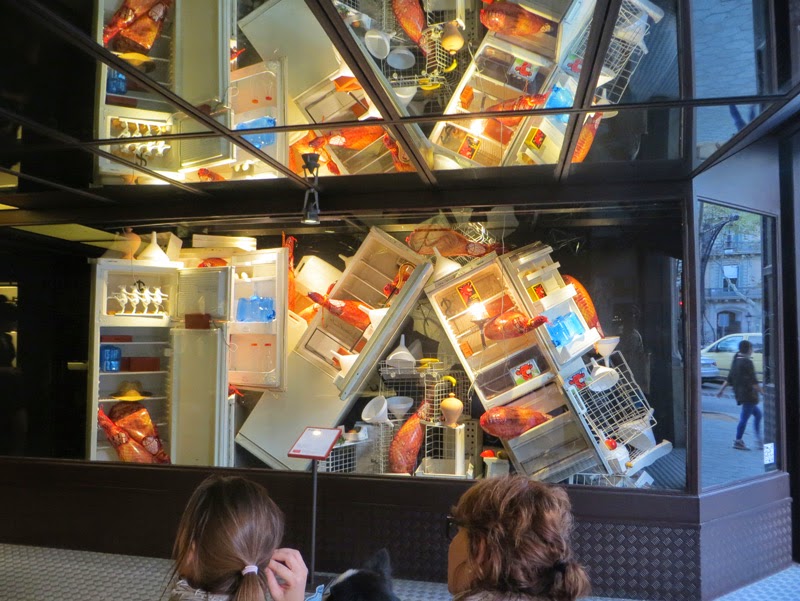 |
| Sagrada Familia: The biggest sandcastle of our time. |
Barcelona is all about the art. And trees. I like that that in a city. Because art is pretty cool, except when it isn't. And trees are pretty nice too.
What kind of art will you find in Barcelona? Modernisme: Catalan modernism, which was mostly an architectural expression. This was an anti-bourgeois movement that pushed towards bohemianism, or attempted to use art to change society at large. (Thanks Wikipedia!)
But what does this really mean for the artscape of Barcelona today? Here are seven kinds of art you'll encounter when you wander the city!
1. Gaudi Modernisme
His works are informed by natural objects yet remain utterly nonrepresentational. (I took a 3D art class once and that was pretty much the assignment. I never knew what the art teacher was on about until I saw the art-process exhibit at Sagrada Familia.)
Gaudi's most famous and most unfinished work is Sagrada Familia, which is elaborate inside (below) and out (top of page).
 |
| Trees or an inverted vertibrae? |
Want something more sprawling than a Cathedral? Visit Park Güell. If you like mosaics, this is a must-see.
 |
| A million little pieces. |
Up close with a mosaic vignette:
 |
| Piece. |
And what would a park be without picturesque gingerbread/candy/delicious looking houses?
 |
| Watch out for ovens and vengeful children. |
To continue the fairytale, the park is guarded by a very nonthreatening lizard/dragon.
 |
| Doesn't even breathe fire. |
Gaudi is also known for other random houses that look like organic alien strongholds plunked down in the middle of the city. To continue the lizard theme, this one is all about lizard skull balconies.
 |
| If their heads are sticking out, just imagine how many lizard bodies are in the building! |
 |
| Creepy. Love it. |
 |
| Not quite his stormtroopers, but close. |
2. Art Nouveau Influences
 |
| Or it would be if it were open. |
But there are other elements around the city that jive with Art Nouveau. Fountains are covered with organic flower designs, and the trees everywhere underscore the beauty of nature.
3. Picasso Modernism
Picasso was exiled from Spain under Franco (Francisco, not James), but he made up for it by gifting Barcelona with almost a thousand of his early works. And his designs were smuggled into Barcelona so that one of his agents could build a museum for them:
 |
| Not quite Artchitecture. |
4. Street Art
Even more modern than Modernisme, there are places around the city you can see street art. Which occupies a special place in the art sphere of subverting authority while maintaining popular appeal.
Notice the "Tourism Terrorism" sign on this building. I saw this message several times in graffiti while walking around the city.
 |
| Totally subverts my tourist experience. |
5. Surreal Storefronts!
In what I can only imagine is a subversion of the anti-bourgeois attitudes of Modernisme, some store fronts in the city are taking surrealism to new levels in advertising themselves, and deconstructing consumerism with refrigerators reflected and floating.
 |
| It's Spain. Of course Ham is the only food in the fridge. |
And even further deconstructing consumerism, and the mechanisms of the consumer society and the production of ham, we have the forgotten raw ingredients of a farm.
 |
| Prepostmodern Farm chic. |
6. The Truly Garish!
And if store fronts begins the subversion and re-purposing of Modernisme goals, the postmodern sculptural protrusions completes it. Establishments use sculptural elements that could be confused as art, and use them as a signpost for cultural decay. This place is called "The Hole."
 |
| Class reshaping? Nope. Just utterly unclassy. |
Fortunately, some of the more loud and in-your-face modern sculptures are harder to unpack and more ambiguous:
 |
| Put your claws up if you feel that happiness is the truth! |
7. And Trees!
In Barcelona, trees have a complex relationship with art.
At times they seem quite unnecessarily obscuring what look to be beautiful architectural elements.
 |
| Clearly sends the sign to tourists: Please Leaf. |
The presence of the trees, while at first they seem to be obscuring a work of art, in fact enhances the mystery of the work, which clearly, if viewed without the veil of foliage, would have lost all sense of mystery and turned into just another ordinary building.
 |
| Nothing to see here anyway. |
 |
| Oh look, more arches. What a triumph. |
But my favorite trees in Barcelona are when the trees themselves are art. There is a coffeeshop/bar next to a wax museum. The decor is a gorgeous indoor bosque with trees with faces. There is very nice tranquil music playing all day, though it is interrupted every half hour or so by lightening and thunder storms in the bar.
 |
| Did I mention there are lightningstorms!? |
Other cities could stand to take a tip or two from Barca and add more art to everywhere.

No comments:
Post a Comment